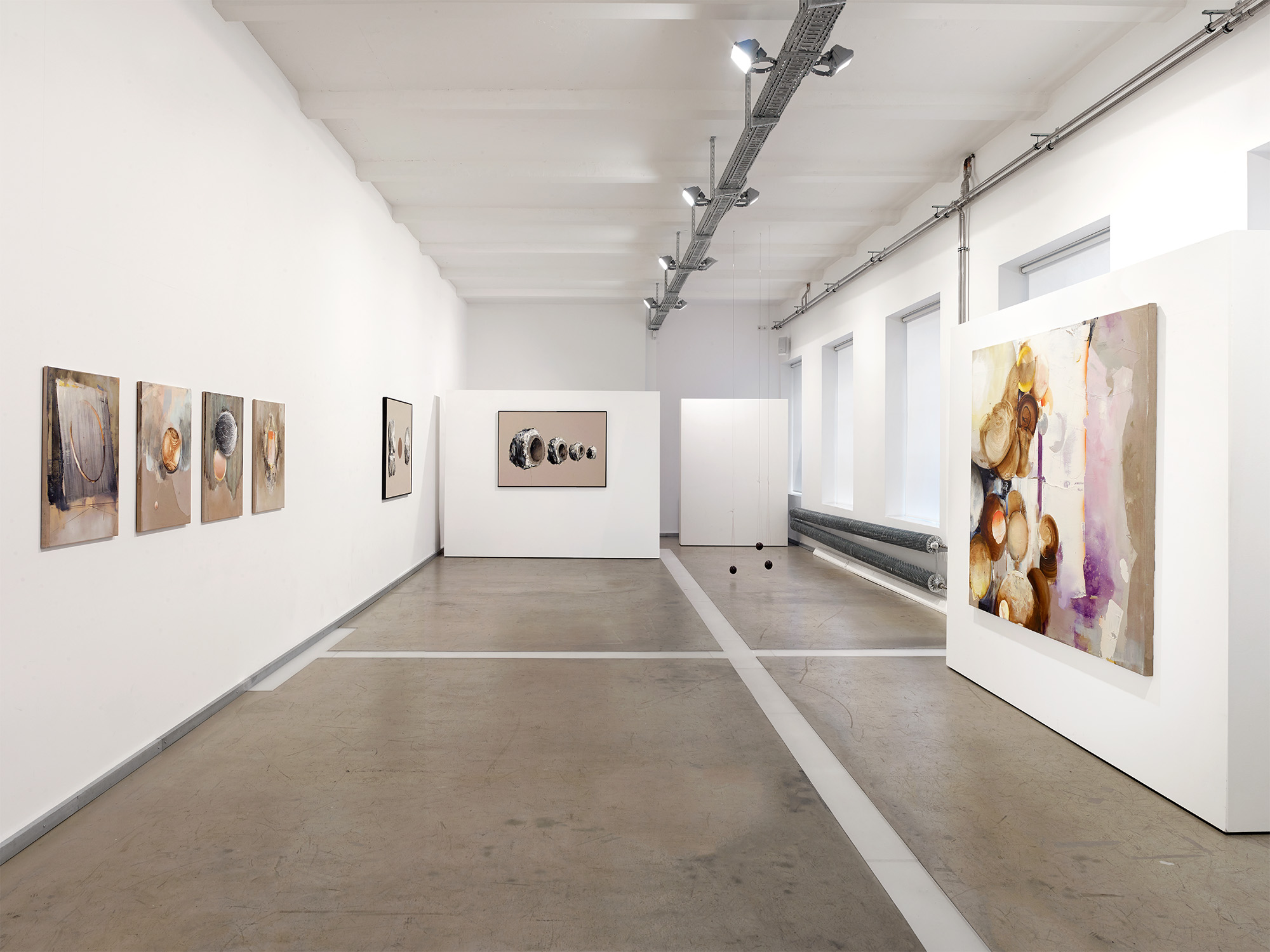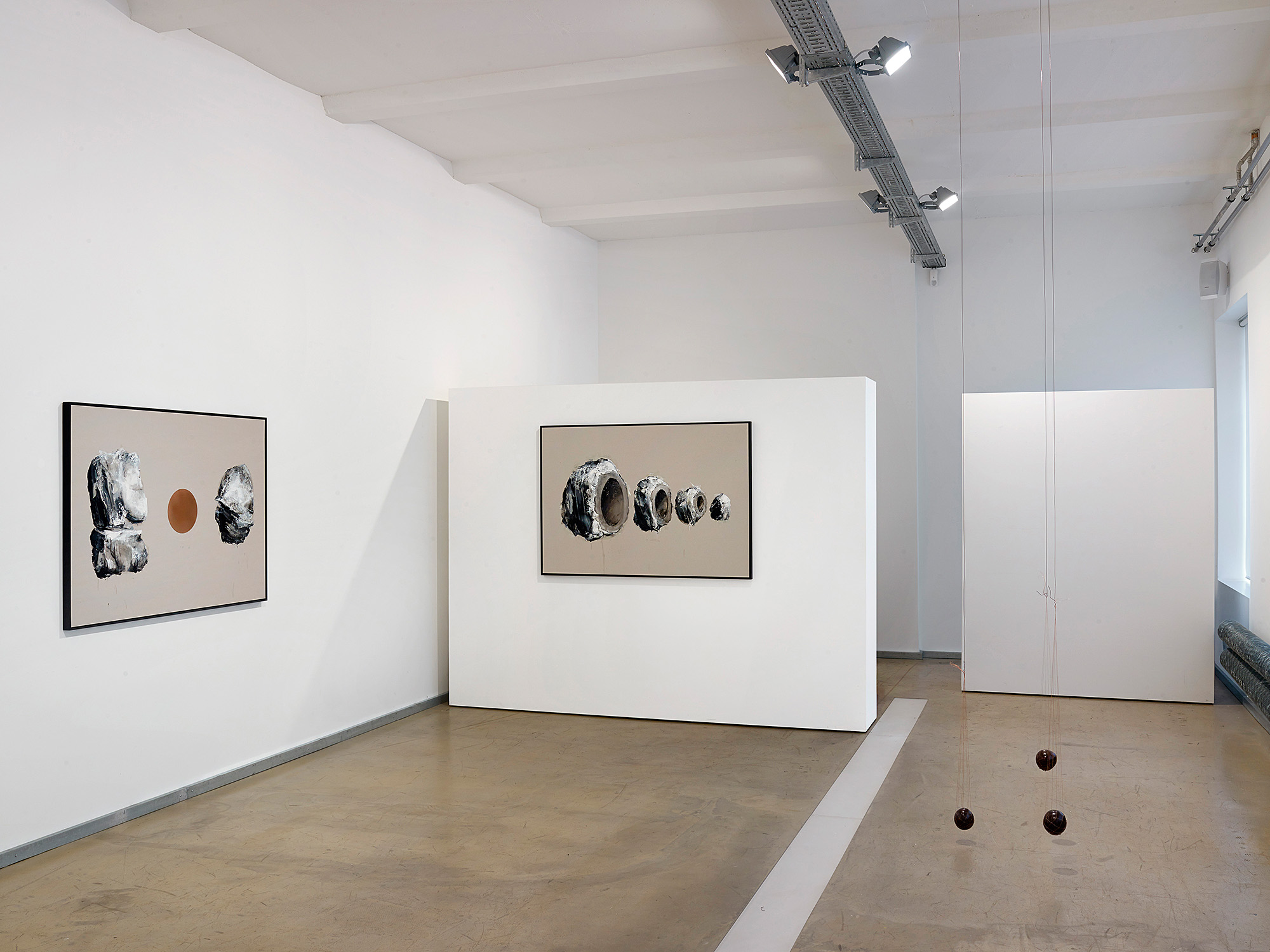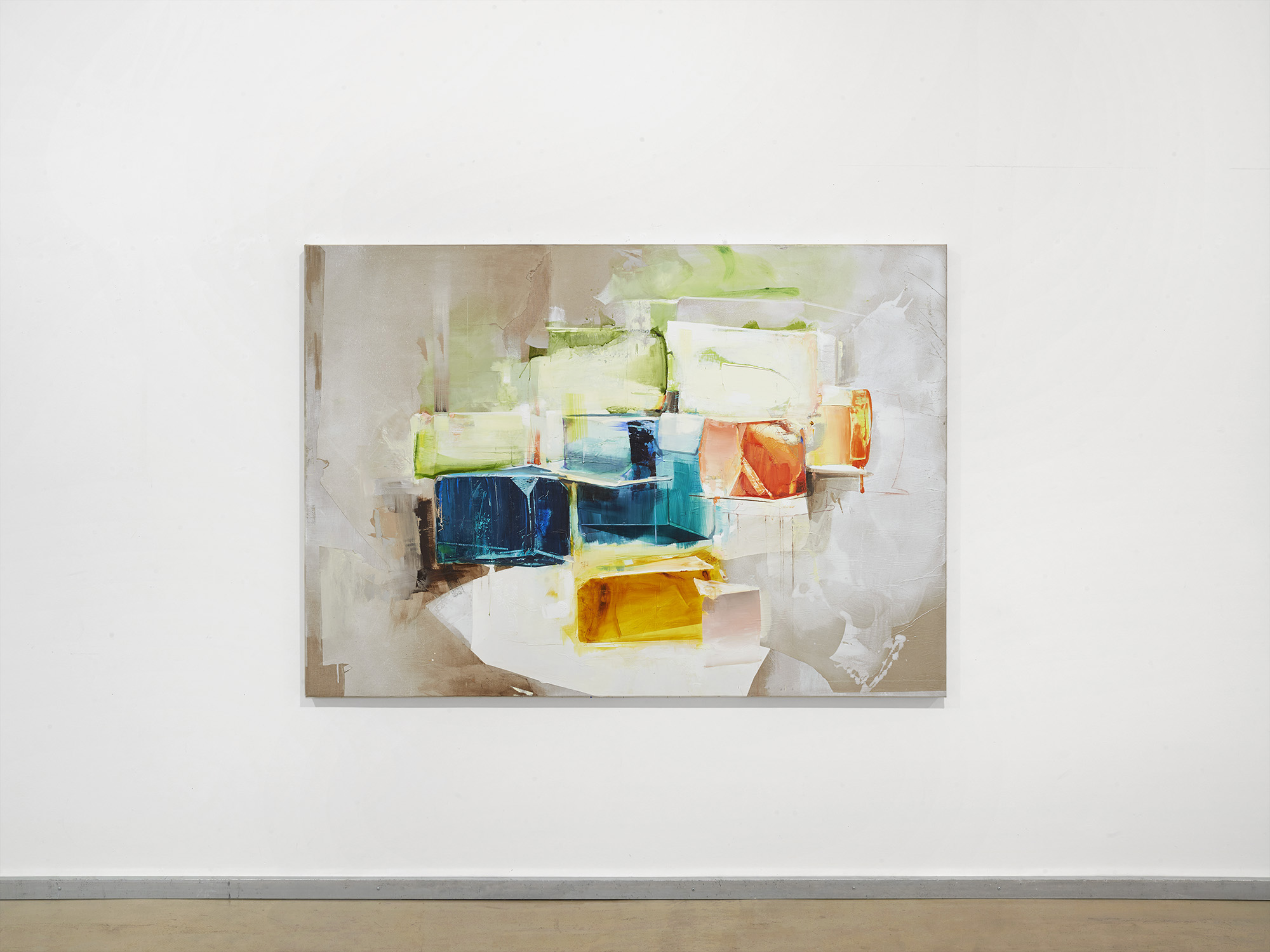











LIAISON
Solo exhibition at Frank Vits Collection, Düsseldorf
November 20 – 30, 2014
Being and Time – Measuring the World
by Gregor Jansen
Is it presumptuous to measure the world?
The science of physics calibrates the world into specific mathematical formulas and physical dimensions. These are both accurate deductions and interpolations of certain simplifications as well as representations of highly complex empirical variables.
The world is measurable – compute it or refute it!
Gravity, magnetism and electricity are as tightly interwoven as painting with light and form. It seems only natural, then, to join the two composites. Researchers are artists; artists are researchers. The world and its phenomena, scientifically or culturally, are closely related. And although we view the rationale of physics as irreconcilable with the subjectivity of art, we are completely mistaken. This can be easily proven! Research is based on questions put forth, in both disciplines in science as in art. The ensuing results are formulas or formulations, descriptions and models of one comprehensible and interpretable point of view. From this perspective, physics and art is one stratum in the inventory of a particular time, a focus or purpose of interpretation. Nevertheless, nothing is, as it seems.
Who has the coconut?
In her latest works, Angelika J. Trojnarski places a medium between these phenomena – painting. How can I paint the South Pole, how do I capture the issue of magnetism? What‘s going on inside metals or crystals? What does it look like, the duality of light, particles or waves? Let us see the Earth as a magnet. The tip pointing north is called the North Pole. Field lines exit the north pole of a magnet and enter its south pole by definition. This explains why the area on electromagnets and permanent magnets from which field lines emerge is called the North Pole, and the area they penetrate is called the South Pole. So, since the magnet’s north pole is attracted by the Arctic magnetic pole, the Arctic magnetic pole is a magnetic south pole. This covers the semantics of semantics.
With Angelika J. Trojnarski’s paintings, we venture into the visual terrain of oil on canvas or cardboard, most often collaged in multiple layers, subtly playing with planes on the pictorial ground. The inner structure of stones, layers and conditions of energy, the Earth and its layers, liquid magma, the conductibility of metals including magnetic stones such as the pyramidal magnetoids behind carved geometric lines of force.
All of these are divinely understandable works of art, as tangible as the suspended constellations of smoothly polished coconuts netted in copper wire. A world in itself, the coconut has a hard shell covered with a delicate web, protecting the juicy meat and a liquid center. And then the copper wire: substantial knotted threads, flat as “solar discs” between stones or as painted surface repeatedly charged with energy – electrical conductor, symbolically and factually palpable, malleable and tenacious. Copper has achieved transcendence within modern painting, much like the golden areoles of the medieval masters.
Building blocks and billiard balls
Two large-format paintings constitute a counter-model to all that has been said before. They are determined by a more abstract pictorial gestus, entwined with delightfully light, practically floating, figurative notions. Beholding the woven structure as an interwoven microcosmic space, we dive into crystalline formations of chemical elements or raw materials in Anatomie des Lichts (Anatomy of Light), 2014, and atomic orbs or globules of fat in Die Große und die Kleine Welt (The Big and the Small World), 2014.
From a macrocosmic perspective, we attain an impression of glass building blocks or gems, of spheres of the universe, planets or even of banal billiard balls. Our brains are constantly comparing what we see to find analogies: the structures of oil on canvas which are heavily collaged – a frequent occurance in Trojnarski’s work – with common patterns of our image memory. This associative game between the pictorial reality and the reality beyond the pictures remains ambiguously open, demanding active visual participation. Trojnarski avoids the unequivocal, brilliantly adjoining layers of abstraction with layers of the figurative.
Both works remind me spontaneously of two Old Masters of pictorial gaiety,
Philip Guston for Anatomie des Lichts and Sigmar Polke for Die Große und die Kleine Welt. Both references convey the potential for a cognitive model in (abstract) painting as well as the alchemistic or scientific model of painting as an instrument of research.
From the dialogue on painting as techné originates the fundamental assertion of Martin Heidegger’s alchemistic discourse – in metaphysics, it is the entirety we seek; in science, we examine singular aspects, seeking that what exists. However, the initial motivation behind the ‘fundamental question’ of philosophy, and therefore, of science, is nothingness – “Why is there existence and not more nothingness?”. As logic proved feckless of grasping nothingness, Heidegger rejects it as a central method of metaphysics. And thus, we’ve come full circle in the pictorial thoughts of Guston, Polke and, of course, Trojnarski. With the deepest understanding of Being and Time, Angelika J. Trojnarski composes models of temporal being with her paintings, as a painted being and yet nothingness – motivated by physical events such as magnetism or gravity and formulated visually.
Here, the word formulated refers, as in the sense of linguistic logic, to the human’s understanding of the advent of being, and therefore he or she formulates himself/herself to become. In that metaphysical sense, painting is never equal to the wordplay.
Sein und Zeit – Vermessung der Welt
von Gregor Jansen
Ist es vermessen die Welt zu vermessen?
Die Physik als Wissenschaft verschafft sich ein Bild der Welt in bestimmten mathematischen Formeln und physikalischen Größen. Diese stimmen als Ableitung und als Interpolierung bestimmter Vereinfachungen, als sie zugleich hochkomplexe Varianten des Empirischen darstellen.
Die Welt ist messbar: Miss es oder vergiss es!
Gravitation, Magnetismus und Elektrizität stehen in einem engen Verhältnis zueinander wie es auch Malerei, Licht und Form tun. Insofern ist es naheliegend, beide Komplexe zusammenzubringen. Forscher sind Künstler und Künstler sind Forscher. Die Welt als auch die Phänomene in ihr, naturwissenschaftlich oder kulturell, sind einander eng verwandt. Und obwohl wir das Rationale der Physik gemeinhin als unvereinbar mit dem Subjektiven der Kunst verstehen, ist dem keinesfalls so, was in einfacher Weise belegbar ist! Forschung basiert auf Problemstellungen, und genau um diese geht es in beiden Disziplinen, in der Naturwissenschaft wie in der Kunst. Die Ergebnisse beider münden in Formeln oder Formulierungen, Beschreibungen und Modellen einer Sicht der Dinge, welche nachvollziehbar und interpretierbar ist. Physik und Kunst sind insoweit eine Bestandssicht einer bestimmten Zeit und damit auslegbare Bestimmung oder Fokussierung. Gleichwohl: Nichts ist so, wie es scheint.
Wer hat die Kokosnuss?
In ihren neuesten Werken setzt Angelika J. Trojnarski eine Ebene zwischen diese Phänomene, und zwar die Malerei. Wie male ich einen Südpol, wie erfasse ich das Problem des Magnetismus? Was ist im Innern der Metalle und der Kristalle los? Wie sieht der Dualismus des Lichts, Teilchen oder Welle, aus? Schauen wir auf die Erde als Magneten. Das nach Norden zeigende Ende wird Nordpol genannt. Durch Definition wurde festgelegt, dass am Nordpol eines Magneten die Feldlinien aus dem Magneten aus – und an seinem Südpol in ihn eintreten. Deshalb bezeichnet man allgemein bei Elektromagneten oder Permanentmagneten Gebiete, aus denen die Feldlinien austreten, als Nordpol und Gebiete, in die sie eintreten, als Südpol. Da der Nordpol des Magneten vom arktischen Magnetpol angezogen wird, ist der arktische Magnetpol ein magnetischer Südpol. Soweit die Sprache der Sprache. In den Gemälden von Angelika J. Trojnarski bewegen wir uns auf dem visuellen Terrain der Ölfarbe auf Leinwand oder Pappe, meist noch vielschichtig collagiert, mit den Ebenen des Bildgrundes subtil spielend. Steine und ihr Innenleben, Schichten von Energien und Energiezuständen, die Erde und ihre Erdschichten bis hin zum flüssigen Magma, die Leitfähigkeit der Metalle bis zu selbstmagnetischen Gesteinen wie den pyramidialen Magnetoiden hinter ausgeschnittenen geometrischen Kraftlinien. All dies ist als virtuose Malerei erfassbar, wie ebenso als hängendes Gebilde von glatt polierten Kokosnüssen, eingefangen von Kupferdrähten greifbar. Auch eine Kokosnuss ist eine fertige Welt mit harter Schale und feinem Gespinst darüber, darunter eine Schicht saftiges Fleisch und das flüssige Innere. Dazu Kupfer, real als geknüpfte Fäden, flach als „Sonnenscheibe“ zwischen Steinen oder als gemalte Fläche mehrfach energetisch aufgeladen: Stromleiter, symbolisch wie faktisch greifbar, gut formbar und zäh. In der Malerei heute gewinnt Kupfer an Transzendenz wie die güldenen Aureolen der mittelalterlichen Meister. Im Übrigen war das Symbol für Kupfer das weibliche Symbol mit Kreis und Kreuz darunter, ein stilisierter Spiegel, das Symbol für die Göttin und den Planeten Venus. Im Angesicht des Spiegels liegt der wahre Meister der Malerei.
Bauklötzchen und Billardkugeln.
Ein Gegenmodell des bislang Gesagten bilden zwei großformatige Gemälde. Sie werden bestimmt durch einen eher abstrakten Gestus, in welchen zugleich wundervoll leicht, fast schwebend, figurative Anleihen eingewoben sind. Erfasst man das Bildgeflecht als einen mikrokosmischen Raum, sehen wir bei Anatomie des Lichts, 2014, in kristalline Gebilde chemischer Elemente oder Grundstoffe, beim anderen, Die Große und die Kleine Welt, 2014, in atomare Kugelformen oder Fettkügelchen. Makrokosmisch betrachtet, erlangen wir den Eindruck von Glasbau- oder Edelsteinen, oder aber von Sphären des Universums, Planeten oder ganz profan von Billardkugeln. Permanent gleicht das Gehirn das Gesehene, die Strukturen der Ölfarbe auf den Leinwänden, welche im Übrigen wie häufig bei Angelika J. Trojnarski stark collagiert sind, mit bekannten Mustern im Bildspeicher des Gehirns ab, und sucht nach Analogien. Dieses assoziative Spiel zwischen malerischer und außerbildnerischer Realität bleibt in seiner Unentschiedenheit offen und verlangt nach einem aktiven Sehen. Trojnarski vermeidet alles, um zu eindeutig zu sein, und tangiert virtuos die Ebenen der Abstraktion mit denen des Figurativen.
Bei beiden Bildern fallen mir auch spontan zwei Altmeister der malerischen Spielfreude ein: Zu Anatomie des Lichts ist es Philip Guston und zu Große und die Kleine Welt ist es Sigmar Polke. In beiden Referenzen vermittelt sich das Potential des Erkenntnismodells von (abstrakter) Malerei wie auch das alchemistische oder naturwissenschaftliche Sondermodell der Malerei als Forschungsinstrument. Im Dialog der Malerei als téchne, entsteht die grundlegende Behauptung des alchemistischen Diskurses nach Martin Heidegger: Der Mensch fragt in der Metaphysik nach dem Ganzen, die Wissenschaft nach einzelnen Aspekten, nach dem Seienden. Jedoch wird erst durch das Nichts die „Grundfrage“ der Philosophie und somit auch der Wissenschaft motiviert: „Warum ist überhaupt Seiendes und nicht vielmehr Nichts?“. Da die Logik sich als untauglich erweist, das Nichts zu begreifen, lehnt Heidegger sie als zentrale Methode der Metaphysik ab. Und damit schließt sich der Kreis malerischen Denkens wie bei Guston, Polke und letztlich auch Trojnarski. Im besten Sinne von Sein und Zeit entwirft Angelika J. Trojnarski mit ihrer Malerei Modelle des zeitlichen Seins, als gemaltes Sein und zugleich Nichts – motiviert durch physikalische Ereignisse wie Magnetismus oder Gravitation und entworfen als Augenschein. Entwerfen meint aber hier, im Sinne sprachlicher Logik, dass der Mensch sich verstehend auf die Ankunft des Seins hin entwerfe, sich also für das Sein offen halte. In diesem metaphysischen Sinne gleicht die Malerei nie dem Wortspiel.